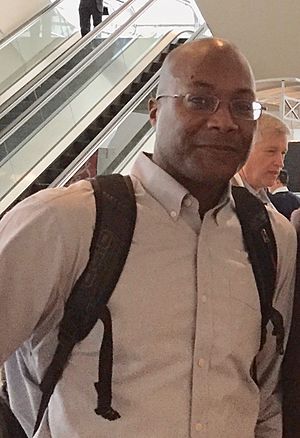Thomas H. Epps III facts for kids
Quick facts for kids
Thomas H. Epps, III
|
|
|---|---|

at the 2016 APS March Meeting
|
|
| Alma mater | Massachusetts Institute of Technology (BS, MS) University of Minnesota (PhD) |
| Known for | Polymer chemistry, polymer physics, polymer science |
| Awards | Fellow of the National Academy of Inventors (2021) |
| Scientific career | |
| Institutions | University of Delaware |
| Thesis | Locating network phases in linear ABC triblock copolymers (2004) |
| Doctoral advisor | Frank S. Bates |
Thomas H. Epps, III is an American chemist and a professor at the University of Delaware. He is an expert in chemical and materials engineering. Professor Epps also helps lead several important research centers. These centers focus on new materials and how they can help our world. His research involves designing and testing special materials called polymers. These polymers can be used in many ways, like making eco-friendly products, delivering medicines, creating better batteries, and even improving protective gear. He also helped start a company called Lignolix. This company turns waste from plants into useful new materials.
Contents
Early Life and Education
Thomas Epps grew up in Chesterfield County, Virginia. His mother, Ruth Epps, was an accounting professor. His father, Thomas H. Epps, Jr, taught chemistry. Young Thomas went to the Massachusetts Institute of Technology (MIT) for his first college degree. He was one of the first students chosen as an American Chemical Society Minority Scholar. This is a special award for talented students.
He continued his studies at MIT and earned a master's degree in chemical engineering in 1999. Later, he moved to the University of Minnesota for his PhD. There, he worked with Professor Frank S. Bates. After finishing his PhD, Epps became a research fellow. He worked at the National Institute of Standards and Technology.
Amazing Polymer Research
In 2006, Professor Epps joined the University of Delaware. Here, he started focusing on how polymers can be used in many different ways. Polymers are like long chains made of many small, repeating units. Think of them like LEGO bricks that link together.
Building with Block Copolymers
Professor Epps is especially interested in something called block copolymers. These are special polymers made from two or more different types of "bricks." He figures out how to make these block copolymers arrange themselves into tiny, organized shapes. These shapes are called nanostructures. By controlling these tiny structures, he can change how the materials work.
He has also explored how these polymers interact with surfaces. He found ways to make very precise nanostructures. These structures can have specific optical and electronic properties. In 2013, he spent time at Massachusetts Institute of Technology. There, he worked with Professor Timothy M. Swager on how polymers can build themselves.
Turning Waste into Wonders
In 2016, Professor Epps showed something really cool. He could make new polymers with special heat properties. And he did it using waste from the paper industry! This is a big step towards being more sustainable. He received a large grant from the National Science Foundation. This money helps him find new ways to make materials from lignin. Lignin is a natural material found in plants.
Professor Epps explained that his goal is "sustainability." This means not just making new materials, but also understanding their impact on the environment. He wants to make sure these new materials are safe and use resources wisely. He then started Lignolix, a company that turns plant waste into useful, sustainable materials. In 2019, Lignolix won a competition at the University of Delaware.
Powering the Future with Polymers
Professor Epps has also worked on polymers for lithium-ion batteries. These are the batteries found in many of our devices. In these batteries, his polymers act like the liquid part. This helps stop problems that can cause sparks or fires. These polymers also allow batteries to charge and discharge quickly. This is because they create tiny pathways for energy to move fast.
Leading Research Centers
In 2020, Professor Epps became a director of the United States Department of Energy Center for Plastics Innovation. This center brings together scientists from different universities and labs. Their goal is to find ways to recycle and reuse plastic waste. Also in 2020, he became the director of the University of Delaware's Center for Hybrid, Active, and Responsive Materials (UD CHARM). This center also brings together researchers to study new materials.
Awards and Honors
Professor Epps has received many awards for his important work. Some of these include:
- 2021 Fellow of the National Academy of Inventors
- 2021 Fellow of the American Institute for Medical and Biological Engineering
- 2020 National Organization for the Professional Advancement of Black Chemists and Chemical Engineers Percy L. Julian Award
- 2020 American Chemical Society Prominent African American Chemists
- 2018 Elected fellow of the Royal Society of Chemistry
- 2017 Elected fellow of the American Physical Society
- 2016 American Physical Society John H. Dillon Medal
- 2015 American Institute of Chemical Engineers Owens Corning Young Investigator Award
- 2014 Kavli Foundation Fellow of the National Academies of Sciences, Engineering, and Medicine
- 2014 Sigma Xi Young Investigator Award
- 2012 Massachusetts Institute of Technology Martin Luther King Jr. Visiting Professor
- 2010 DuPont Professor Award
- 2009 Presidential Early Career Award for Scientists and Engineers

